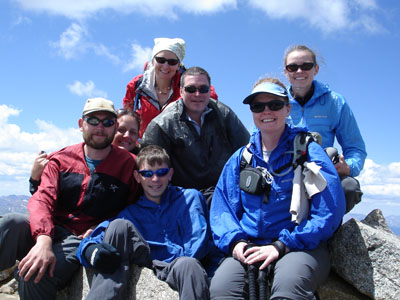| 079 | The Pressure on Breathing | 2009-05-06 |

Back on 04/17/09 I wrote a blog on acclimating and wanted to do a little follow up on the subject of breathing in the mountains.
For decades I have preached the benefits of pressure breathing to help acclimate to altitude. I had read about pressure breathing in the great mountaineering know-how books. I had seen videos on acclimating and the advantages of pressure breathing. I had been instructed on how to pressure breathe (though I never thought I was very good at it.) And I had instructed green (as in beginner) mountaineers on how to pressure breathe. I thought pressure breathing was the answer to acclimatization.
Then, Christmas a few years back my wife bought me a biography on Charles Houston, the foremost authority on altitude sickness and noted mountaineer. According to the book Houston disavowed the benefits of pressure breathing back in the 1940’s.
Below is an excerpt from "Brotherhood of the Rope":
Barry Commoner had previously developed a maneuver called Emergency Pressure Breathing, in which the subject was told to take a deep breath, compress his lungs by trying to breathe out against pursed lips, and then relax. The rationale was that this would increase the pressure of oxygen in the lungs and enable survival if repeated several times a minute. But the procedure was hard to do and even harder to teach. Eventually Charlie determined that over-breathing - a form of hyperventilation - rather than pressurizing, was the answer to improved blood oxygen and, ultimately, survival.
"Brotherhood of the Rope - Biography of Charles Houston", by Bernadette McDonald, p.80
Houston made this discovery while studying the effects of altitude as a flight surgeon. But, pressure breathing is still taught as the only way for a flatlander to climb mountains like Rainier. So what gives?
In the past I had told others they needed to pressure breathe and had instructed them on how to breathe properly. Of course (as mentioned above) I never felt like I could change the pressure of air in my lungs by pursing my lips. It is like believing in the tooth fairy or any other mythological figure, it is fun to believe, but you know they are not real. I did it, not because I thought it was really working; but on the chance the technique could help a little. And to that end if you think pressure breathing is changing the pressure in your lungs and helps you acclimate, then purse away. If not, breathe freely and often.
Why, then, is pressure breathing still being taught in mountaineering books and schools? Possibly the writers and teachers don’t know better, or they too have just done it because someone showed them how and told them they must pressure breathe in order to acclimate (like me). The instructor explains, “The reason you are not acclimating is that you are not pressure breathing correctly. See do it like me, inhale, purse your lips, exhale.” Of course the instructor forgets to mention that she lives in the mountains and is already as acclimated as a mountain goat! If your teacher tells you to purse your lips, then pucker up and do it or find another teacher. Of note, a side benefit of pressure breathing is that it does make a lot of noise so the instructor at least knows whether the student is breathing hard or hardly breathing.
Pressure breathing is definitely not wrong and if it increases the intake of air it might help. Though, Houston suggests that simple hyperventilating works better. Adjust your breathing and pace so that you flow steadily up the hill as you drink lots of water and you will get there.
So, to all those that I have given the wrong advise over the years, please forgive me. From now on, you are liberated from pursing your lips! But, don’t forget to breathe.
Happy trails.